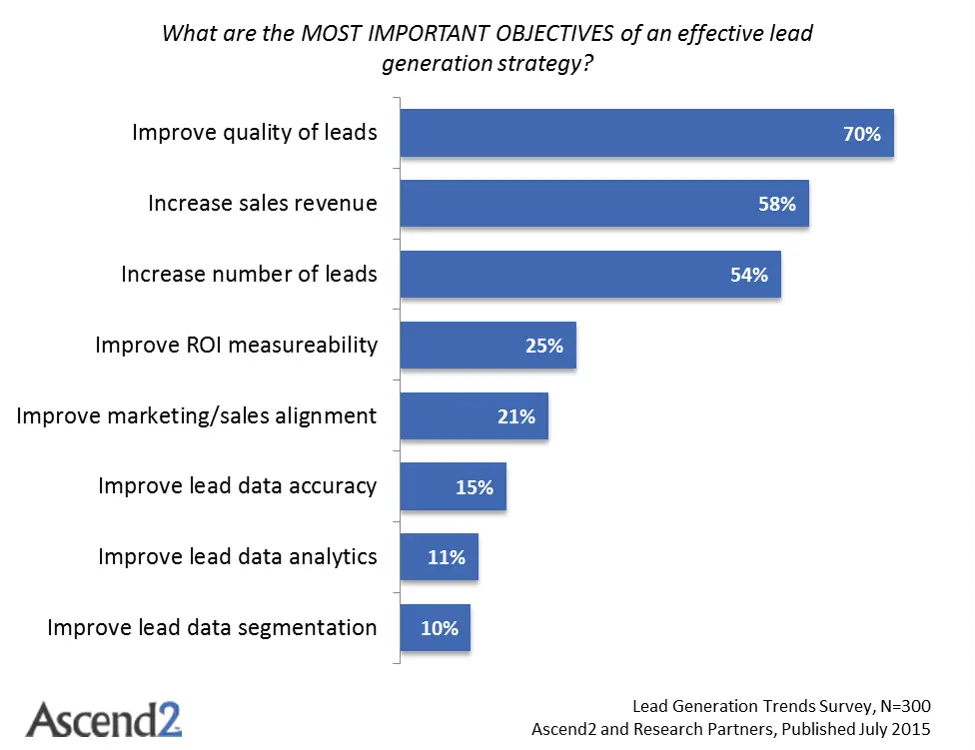When venturing into Lead Generation Strategy, the initial question is whether to prioritize Quality Leads or Quantity of Leads.
Imagine your team proudly announcing, "We've garnered 5,000 leads this week." It's undoubtedly a moment of pride. The common assumption is that more leads result in higher conversions.
However, this notion is misleading. According to a survey on Lead Generation by Ascend2, 70% of B2B marketers consider enhancing lead quality as the foremost objective of a lead generation strategy, while 54% prioritize increasing the number of leads.

We all recognize that lead generation plays a pivotal role in business, but quality lead generation can work wonders for your sales team.
In reality, lead quality outweighs lead quantity in ensuring business success. Concentrating on generating high-quality leads can elevate your conversion rates, boost customer lifetime value, decrease customer acquisition costs, and bolster your brand reputation.
Before we explore various lead generation strategies, it's crucial to understand the ethics and legality of lead acquisition.
Ethics and Legality of Lead Acquisition

1. Ethics of Lead Acquisition
- Transparency: Inform individuals about why and how their data is being collected.
- Consent: Obtain explicit consent before collecting or using personal information.
- Privacy: Protect data privacy by storing information securely and limiting access.
- Respect: Honor opt-out requests promptly and provide easy ways to unsubscribe.
2. Legality of Lead Acquisition
- Data Protection Laws: Comply with regulations like GDPR [General Data Protection Regulations], which require explicit consent and provide data access rights.
- Do Not Call Lists: Avoid contacting individuals on Do Not Call lists.
- Email Marketing Laws: Follow laws like the CAN-SPAM Act, ensuring clear opt-out methods and honest subject lines.
- Fair Use of Data: Use data only for its intended purpose and in a lawful manner.
Let's begin our journey by first understanding the different lead sources.
Understanding Lead Sources for Effective Cold Calling Service

Effective lead generation begins with understanding where your leads come from. Different sources can provide leads with varying interest levels and readiness to convert.
Here, we'll delve into some key lead sources and how to optimize them for your business.
1. Direct Inquiries
Direct inquiries are leads generated from customers who proactively contact your business. These can come through various channels, such as phone calls, emails, or in-person visits.
Direct inquiries are highly valuable because they indicate a clear interest in your product or service.
To maximize the potential of direct inquiries:
Prompt Response: Ensure inquiries are answered promptly to maintain the lead's interest.
Personalized Interaction: Tailor your communication to address the specific needs and questions of the lead.
Efficient Follow-up: Use CRM tools to track and follow up on these inquiries systematically, ensuring no lead is lost.
2. Website and Online Forms
Your business website is a crucial tool for lead generation. By integrating various forms and call-to-action buttons, you can capture leads effectively.
Here are some strategies to enhance lead capture through your website:
Subscription Forms: Encourage visitors to subscribe to newsletters or updates by offering valuable content in return.
Contact Forms: Provide simple and accessible contact forms to make it easy for potential leads to get in touch.
Content Downloads: Offer downloadable resources such as eBooks, whitepapers, or case studies in exchange for contact information.
3. Social Media Platforms
Social media platforms are powerful tools for engaging with potential leads. By actively participating in conversations and sharing valuable content, you can attract and capture leads. Here's how to leverage social media for lead generation:
LinkedIn: Ideal for B2B lead generation, LinkedIn allows you to connect with professionals, join relevant groups, and share industry insights. Utilize LinkedIn's lead gen forms to capture leads directly from ads.
Facebook: With a vast user base, Facebook is suitable for both B2B and B2C lead generation. Create engaging posts, run targeted ads, and use lead ads to collect information directly on the platform.
Twitter: Use Twitter to share timely updates, participate in industry discussions, and engage with followers. Utilize Twitter's lead generation cards to collect leads directly from tweets.
Proven Active Lead Generation Strategies for Business Growth

Active lead generation involves proactive efforts to attract and capture potential customers.
1. Content Marketing
Content marketing is a powerful strategy that involves creating and sharing valuable content to attract and engage potential customers.
The goal is to provide relevant and helpful information that addresses your target audience's needs and pain points, prompting them to share their contact information in exchange for access to this content.
Key Elements of Content Marketing:
Blog Posts: Regularly publish informative and engaging blog posts that address common questions and challenges your target audience faces. Use SEO techniques to ensure your content ranks well on search engines, driving organic traffic to your website.
Ebooks and Whitepapers: Offer in-depth guides and reports that require users to fill out a form to download. This not only provides valuable information but also captures leads.
Infographics and Visual Content: Create visually appealing content that is easily shareable on social media, increasing your reach and attracting potential leads.
2. Networking Events
Networking events are an excellent opportunity to meet potential leads and build relationships. These events can include industry conferences, seminars, trade shows, and local business gatherings.
Strategies for Effective Networking:
Preparation: Before attending an event, research the attendees and identify key people you want to connect with. Prepare an elevator pitch about your business and the value you offer.
Engagement: Actively participate in discussions, panels, and workshops. Share your insights and listen to others to build rapport.
Business Cards: Collect and distribute business cards. Appointment setting indicates a high level of lead engagement and potential interest, often signaling readiness for further sales discussions or conversions.
Follow-up: After the event, follow up with the people you met. Send personalized emails or connect on LinkedIn to keep the conversation going.
3. Partnerships and Collaborations
Forming partnerships and collaborations with other businesses and industry players can be an effective way to generate leads.
You can exchange leads and expand your reach by leveraging each other's networks.
Types of Partnerships:
Strategic Alliances: Partner with businesses that offer complementary products or services. For example, a web design agency could partner with a digital marketing firm to refer clients to each other.
Co-Branding: Collaborate on marketing campaigns, events, or products with another brand. This can help you tap into their audience and generate new leads.
Affiliate Programs: Establish an affiliate program where partners earn a commission for referring leads or sales to your business.
Guest Blogging and Cross-Promotions: Write guest posts for each other's blogs or co-host webinars to share expertise and audience.
Smart Approaches for Purchasing High-Quality Leads

Purchasing leads can be a viable strategy for businesses looking to expand their customer base quickly. This involves outsourcing leads from third-party vendors who specialise in generating and selling prospect contact information.
1. Third-Party Vendors
Third-party vendors are companies that specialise in generating and selling leads to businesses for cold-calling. These vendors use various methods to collect contact information of prospects interested in your products or services.
Process of Buying Leads
Identify Needs: Based on your target market and business goals, determine the type of leads you need. This could include demographic information, industry, and job title.
Research Vendors: Look for reputable vendors in your industry or target market. Read reviews, ask for references, and compare offerings.

Purchase Leads: Once you've selected a vendor, purchase the leads based on the agreed-upon criteria. Ensure you understand the purchase terms, including the cost per lead and any guarantees on lead quality or exclusivity.
Integration: Integrate the purchased leads into your CRM system and begin your outbound cold calling process.
2. Criteria for Vendor Selection
Choosing the right lead provider is important to ensure the quality and relevance of your purchase leads. Here are some essential criteria to consider when selecting a vendor:
- Reputation: Check the vendor's reputation through online reviews, testimonials, and industry references.
- Sourcing Methods: Understand how the vendor generates their leads. Ensure their methods are ethical and compliant with data privacy laws. Ask about their data collection processes, opt-in procedures, and how they verify the accuracy of the leads.
- Lead Freshness: Freshness is critical for the effectiveness of purchased leads. Confirm how recently the leads were generated and how frequently the vendor updates their database.
- Customization and Targeting: Ensure the vendor can provide leads that match your specific criteria, such as geographic location, industry, company size, or job title. Customization increases the likelihood that the leads will be relevant to your business.
- Cost and Guarantees: Compare pricing among different vendors and understand what is included in the cost. Look for any guarantees on lead quality, such as replacements for invalid or non-responsive leads.
3. Legal Considerations
When purchasing leads, it's essential to comply with relevant laws and regulations to protect your business and maintain customer trust.
Here are critical legal considerations:
- Privacy Laws: Ensure the vendor complies with privacy laws such as the General Data Protection Regulation (GDPR) in Europe, the California Consumer Privacy Act (CCPA) in the United States, and other relevant local laws.
- Consent Norms: Verify that the leads you purchase have given proper consent for their information to be shared and used for marketing.
- Data Security: Ensure the vendor has robust data security measures in place to protect the leads' personal information. This includes secure data storage and transfer practices.
- Compliance Documentation: Request documentation from the vendor proving compliance with relevant laws and consent norms. This can serve as an essential safeguard for your business.
Maximizing Results with Lead Generation Services and Tools

Using lead generation services and tools involves leveraging various technologies and platforms to automate lead capture, manage leads effectively, and optimize digital marketing efforts for generating leads.
Here are some essential methods and tools commonly used:
1. Automated Tools
- CRM Tools: Customer Relationship Management (CRM) software helps businesses organize, track, and manage interactions with leads and customers. It automates tasks such as lead scoring, email campaigns, and follow-ups, streamlining the lead management process.
- Lead Generation Software: This includes tools that facilitate lead capture through forms, pop-ups, landing pages, and gated content. These tools often integrate with CRM systems to ensure seamless lead management.
2. Online Advertising
- Google Ads: Google's advertising platform is utilised to create targeted ads that appear in search results and on websites within the Google Display Network. Google Ads allows for precise audience targeting based on keywords, demographics, and user behaviour.
- Social Media Advertising: Platforms like Facebook, LinkedIn, Twitter, and Instagram offer robust advertising capabilities to reach specific audiences. Ad campaigns can target users based on interests, demographics, job titles, and behaviours, making them practical for lead generation.
3. SEO and SEM
- Search Engine Optimization (SEO): This involves optimizing your website and content to rank higher in search engine results pages (SERPs). SEO techniques include keyword optimization, content creation, link building, and improving website performance. Higher rankings lead to increased organic traffic and potential leads.
- Search Engine Marketing (SEM): This involves paid advertising on search engines like Google, where ads appear above or alongside organic search results. SEM strategies include keyword bidding, ad copy optimization, and landing page creation to drive targeted traffic and capture leads.
Optimizing Your Sales Process: Lead Qualification and Management

Effectively managing and qualifying leads is crucial for maximizing the efficiency of your cold-calling team and ensuring that your sales efforts yield the best results.
Sales Development Representatives (SDRs) play a crucial role in prospecting, qualifying leads, and initiating meaningful conversations to drive sales opportunities for the business.
1. Qualifying Leads
Lead qualification involves evaluating potential leads to determine their likelihood of becoming paying customers, ensuring your team focuses on high-quality leads.
Steps to Qualify Leads:
Define Criteria: Establish clear criteria for a qualified lead, such as budget, authority, needs, and timeline (BANT framework).
Lead Scoring: Implement a lead scoring system to rank leads based on their potential value.
Data Enrichment: Gather additional information from social media profiles and company websites to create comprehensive lead profiles.
Behavioral Analysis: Track interactions with your website, emails, and content to gauge interest and readiness to purchase.
Qualification Questions: Use initial contact to gather information about the lead’s needs, budget, and decision-making process.
Benefits of Qualifying Leads:
Directs efforts towards leads with higher conversion potential.
Saves time and resources by focusing on promising prospects.
Improves the likelihood of turning leads into customers.
2. Maintaining a Lead Database
A well-maintained lead database is essential for effective lead management and sales development. It helps keep track of interactions, ensure timely follow-ups, and nurture leads.
Best Practices for Managing and Nurturing Leads
Centralized Database: Use a CRM system to store and organize all lead information in one place.
Regular Updates: Keep your database up-to-date by reviewing and updating lead information.
Segmentation: Segment leads based on criteria such as industry, company size, job role, and engagement level.
Automated Workflows: Set up automated workflows for routine tasks such as follow-up emails and lead scoring updates.
Track and Analyze: Monitor the performance of your lead management strategies through analytics.
Benefits of Maintaining a Lead Database:
Keeps all lead information organized and easily accessible.
Enables personalized and timely communication with leads.
Ensures leads are nurtured and ready for a sales caller to reach.
Conclusion
A strategic approach to lead sourcing is crucial for businesses to achieve sustainable growth and success. It ensures that resources are allocated efficiently, targeting leads with the highest potential for conversion.
This approach also allows businesses to optimize their marketing efforts, improve lead quality, and increase sales effectiveness.
By strategically sourcing leads, companies can enhance their customer acquisition process, build strong relationships with prospects, and ultimately drive revenue and business growth.
Also, cold calling can provide access to specialized skills and expertise, leading to better results in lead conversion.
